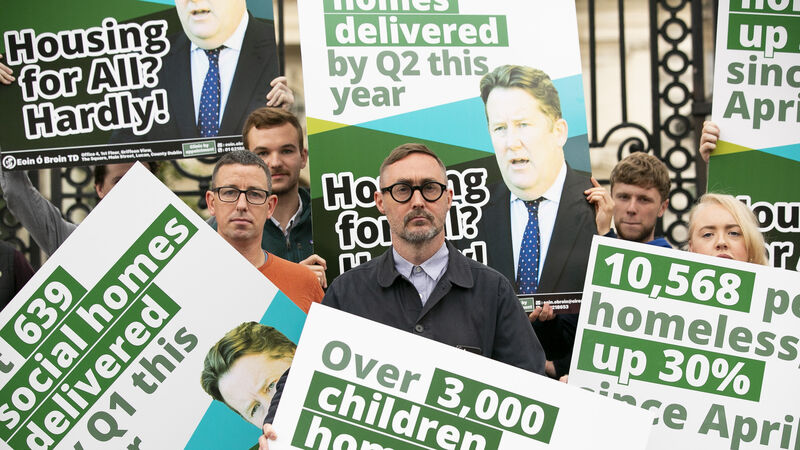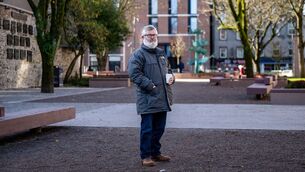Paul Hosford: Housing plan has one year to deliver change — or be consigned to the bin

Sinn Féin spokesperson on Housing, Eoin Ó Broin, on the one-year anniversary of the publication of the government’s ‘Housing for All’ plan. When it was launched, the Government trumpeted four main pathways to a more sustainable housing system. Photo: Gareth Chaney/ Collins Photos
A year ago yesterday, one of the cornerstone policies of this government launched to some fanfare.
Housing For All is, as Housing Minister Darragh O'Brien will tell you, a multi-year, fully-funded plan to overhaul Ireland's housing system. To make homes more available, cheaper and greener, revitalising towns and cities and cut through the red tape of the planning system.
This document was a response, 14 months into the life of a government brought to the Dáil in an election where housing was the second-most important issue, to a systems failure of the worst kind.
The housing crisis was one which previous governments seemed to just arrive in, with no collective idea of how it had gotten there. Speeches were made, figures announced, alarms raised, but in the last two years of the Fine Gael minority government, it seemed to dawn on the country's leaders that this was a bad situation and going to get worse.
The opportunity to build on scale during the crash in a bid to stimulate the economy and ensure a steady supply of homes was squandered as dwelling completions fell to 4,574 in 2013.
By the time building restarted in earnest — planning permissions rebounded to just over 13,000 in 2015 — the economic recovery was well underway and younger people who had been unable to afford to purchase homes or get mortgages during the downturn were ready to jump on the so-called property ladder.
However, that lack of available housing meant that prices, which had dipped to nearly half of their 2005 levels, started to tick upwards and by 2017, they had reached Celtic Tiger levels once more.
This led to a return of people sleeping overnight at launches of new-build homes, paying booking deposits before ever setting foot in a show home and paying what were considered then to be exorbitant prices. Half a decade later and those people look at the current market as if they were Neo from The Matrix films, contorting and twisting to implausibly dodge a bullet.
While the current plan was always intended as a long-term overhaul of a system which most would say was dysfunctional and not delivering, it is fair to reflect a year in on just whether it is working and the answer is, well, complicated.
When it was launched, the Government trumpeted four main pathways to a more sustainable housing system:
- Supporting home ownership and increasing affordability;
- Eradicating homelessness, increasing social housing delivery and supporting social inclusion;
- Increasing new housing supply;
- Addressing vacancy and make efficient use of existing stock.
On the first strand, the Government will point to a number of its initiatives, most keenly the First Home Shared Equity Scheme, which supports first-time buyers in purchasing newly built homes nationwide. It sees the State take an equity stake in a new-build home in order to bridge the affordability gap.
It aims to help the purchase of 8,000 new homes by 2026. The Opposition, however, says it's a "pro-developer scam" which will add debt to those who partake when the State's equity servicing charge begins to be repaid.
The Government is very clearly keen on increasing the number of people who own homes, but the question remains whether this is being done by hook or by crook or is sustainable. A similar scheme to the Government's equity scheme in Britain had little effect.
Read More
A report by the House of Lords into the British Help-to-Buy scheme, which enables first-time buyers to obtain an equity loan from the Government of up to 20% (or up to 40% in London) of the market value of new-build homes, found it will have cost £29bn (€34bn) by the end of next year and would have been better spent on new housing supply.
"We find that the Government’s Help to Buy scheme, which will have cost around £29bn in cash terms by 2023, inflates prices by more than its subsidy value in areas where it is needed the most. This funding would be better spent on increasing housing supply," the report says.
The Lords report quotes Christian Hilber, professor of economic geography at the London School of Economics and Political Science, as highlighting analysis which shows schemes like Help To Buy have increased supply, but mostly in places where it is easier to add new homes, anyway.
On affordability, it was telling that in June, a smaller-than-anticipated rise in house prices was considered good news. The CSO’s Property Price Index for June 2022 stood at 163.6 points, which is equal to the highest level recorded at the peak of the property boom in April 2007.
In the year to June, the price of properties in Ireland rose 14.1%. This is slightly lower than the 14.4% yearly increase reported in May 2022, so while house price inflation had cooled, the actual price of homes was still rising.
All the while, homelessness has hit record numbers. The number of adults and children who are homeless across Ireland has reached a new record high of 10,568, according to Department of Housing figures for July. Over 3,100 of those are children.
The document envisages that social housing delivery will increase to 9,500 homes on average a year by 2030, slightly above last year's 9,183. At the end of the first quarter this year, 8,776 social homes were onsite, with an additional 11,551 homes at design and tender stage.
With homes brought in through purchase of Part V acquisitions, it's possible the Government will see that 9,500 figure hit, but with 60,000 households on a social housing waiting list, even that figure feels low.
While the Government has been keen to avoid any notion of a so-called "silver bullet" in housing, the refrain that supply will be key has been repeated.
The Taoiseach will often point to supply as the key issue in housing, implying that should yearly house completions reach the 33,000-a-year mark envisaged in Housing for All, prices will fall as demand is met.
However, this ignores the weight of data which suggests that supply does very little to address overall affordability. If, for example, it costs €250,000 to build a home no developer in the world will sell it for less than that regardless of how many are being sold in the overall market.
The truth is that the housing system which was inherited by Darragh O'Brien was fundamentally broken as evidenced by the number of actions contained in Housing for All. Mr O'Brien has called for such measures as a complete overhaul of the planning laws - not exactly a signal of a functioning housing market.
And, to his credit, Mr O'Brien understands that fundamental change was and is needed in the sector.
However, the public will question the pace at which this change is being achieved. A year into Housing for All many would-be homeowners say that the prospect of owning their own home is nowhere closer than it was when the government came to power in June 2020.
Like all glossy documents put together by a government, Housing for All will only be considered as much a success as the impact of it being felt on the ground. To that end the plan must deliver real tangible change in the next 12 months or be written off as just another aspirational failure.















